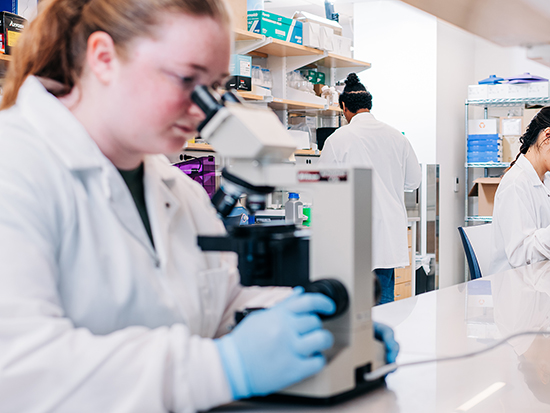 New drugs and devices are transforming the treatment of diseases that affect millions of Americans, including cancer, diabetes, sleep apnea and obesity. At the same time, gene therapies are giving people with sickle cell disease and other inherited diseases hope that a single treatment might cure their conditions once and for all.
New drugs and devices are transforming the treatment of diseases that affect millions of Americans, including cancer, diabetes, sleep apnea and obesity. At the same time, gene therapies are giving people with sickle cell disease and other inherited diseases hope that a single treatment might cure their conditions once and for all.
There has perhaps never been a better time to have access to clinical trials, and patients at UAB have never had so many opportunities to take part. Over the past decade, UAB has become a national leader in clinical trials — studies examining the use of new treatments in people.
Expanding access to clinical trials to even more people in Alabama and across the region is one of the priorities of UAB’s Research Strategic Initiative. “The purposeful focus on strengthening the clinical trials enterprise — among other key opportunities — in UAB’s Research Strategic Initiative will help preserve and protect our mission to expand patients’ access to lifesaving, life-changing medical advancements,” said UAB President Ray L. Watts.
In order to support the expanding infrastructure needs of UAB’s clinical trials enterprise, the university is establishing the Academic Research Organization for Clinical Trials, or ARO-CT. Its mission, leaders say, is to act as a central hub supporting clinical trials activities across the six UAB schools and the College of Arts and Sciences that conduct trials.
The UAB ARO-CT will be responsible for a wide range of functions essential to clinical trial operations, including contracting, clinical billing review, financial services, regulatory affairs, industry relations and the OnCore clinical trials management system. By bringing these functions together under a single organization, the ARO-CT will allow UAB to efficiently scale up clinical trials accruals by streamlining processes required for study startup and conduct.
“We started working on the ARO-CT partnership with the Heersink School of Medicine a number of years ago,” said Jason Nichols, O.D., Ph.D., senior associate vice president for Research. “Then COVID hit and our clinical trials enrollments were still going strong, and we realized we needed to move this ARO-CT concept forward.” UAB’s engagement with consultants in the early phases of the Research Strategic Initiative validated this approach, Nichols added. UAB President Ray Watts and UAB Health System CEO Dawn Bulgarella are champions of the ARO-CT, signaling its importance to the institution’s strategic planning.
The UAB ARO-CT will be responsible for a wide range of functions essential to clinical trial operations, including contracting, clinical billing review, financial services, regulatory affairs, industry relations and the OnCore clinical trials management system. By bringing these functions together under a single organization, the ARO-CT will allow UAB to efficiently scale up clinical trials accruals by streamlining processes required for study startup and conduct.
This centralized approach will also allow successful practices from specific units to be shared across the entire research enterprise and early engagement with study teams to better understand their accrual goals and support them in meeting those goals. Meeting accrual goals is essential to enrolling the right number of patients, which in turn allows trials to generate meaningful statistics that uphold the scientific validity of the research — ultimately expanding patients’ access to potential breakthrough treatments.
A key step in the development of ARO-CT, Nichols said, was “hiring a leader for our clinical trials,” which came in January 2025, with the appointment of David Kimberlin, M.D., as associate vice president for Clinical Trials, a newly established role. Kimberlin, a professor in the Department of Pediatrics, has decades of experience in clinical trials for rare viral diseases that affect children. “UAB has tremendous clinical research and clinical trial capacity as well as a large volume of patients,” Kimberlin said. “The opportunities are boundless. Our job in the ARO-CT is to remove obstacles so that we can meet our key objectives, which are to reduce the time to activation for new trials and increase patient accrual to those trials.”
In addition to Kimberlin’s appointment, Mike Matthews was recently named assistant vice president for Research Technology and Clinical Trials Operations. In this newly created role, Matthews brings 20 years of clinical trials administration experience to lead the ARO-CT operational units, including contracting, budgeting, regulatory, clinical billing review and OnCore. He will also continue to lead the Research Technology and Communications team in the Office of Research, which includes the implementation of the myUABResearch electronic research administration tool.
“The advantage of this organization is the speed at which we can attack problems,” Matthews said. “We figure out who we need to talk to and take action.” That includes being proactive to keep principal investigators up to date and to communicate the urgency of clinical trials work to personnel across the enterprise, ultimately to the benefit of patients in the community, state, and region.
Ongoing efforts to optimize the processes within the ARO-CT framework are already yielding results. The average time for completing a clinical trial agreement has decreased by 40 percent, from 140 calendar days in 2022 to 84 days in 2025. “The industry standard target is 90 days, and we plan to do much better than this,” Nichols said.
With a centralized structure, experienced leadership and a commitment to continuous optimization, the ARO-CT will elevate UAB’s clinical trials enterprise and expand access to life-changing medical breakthroughs for patients across Alabama and beyond.